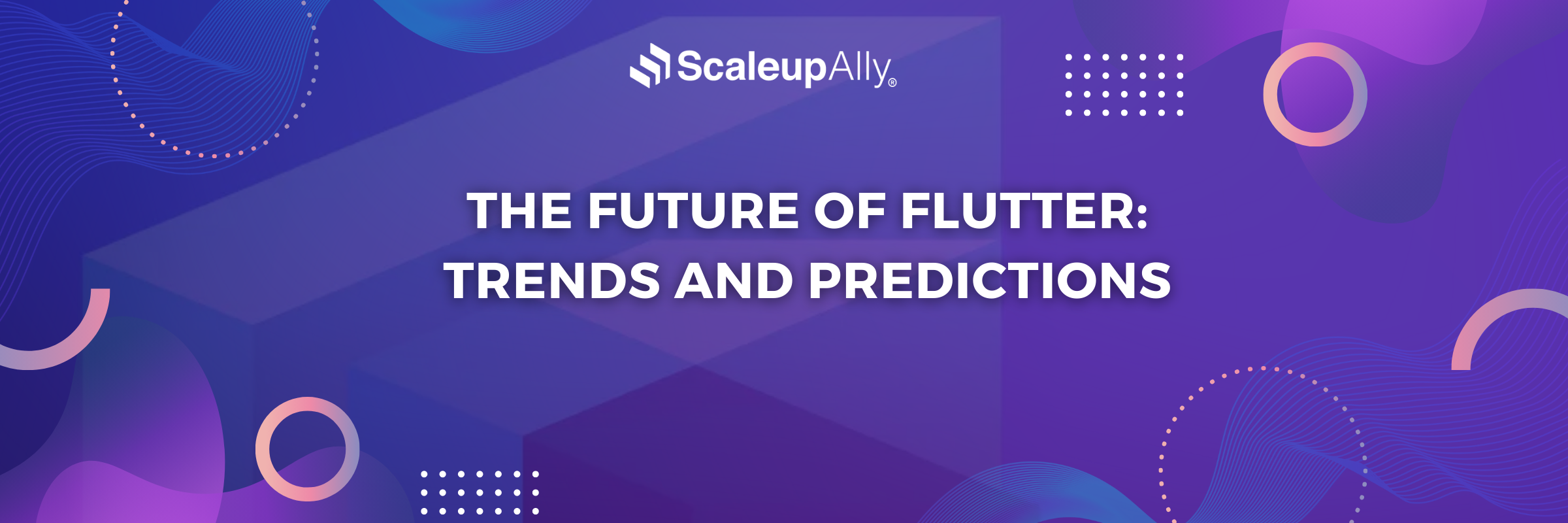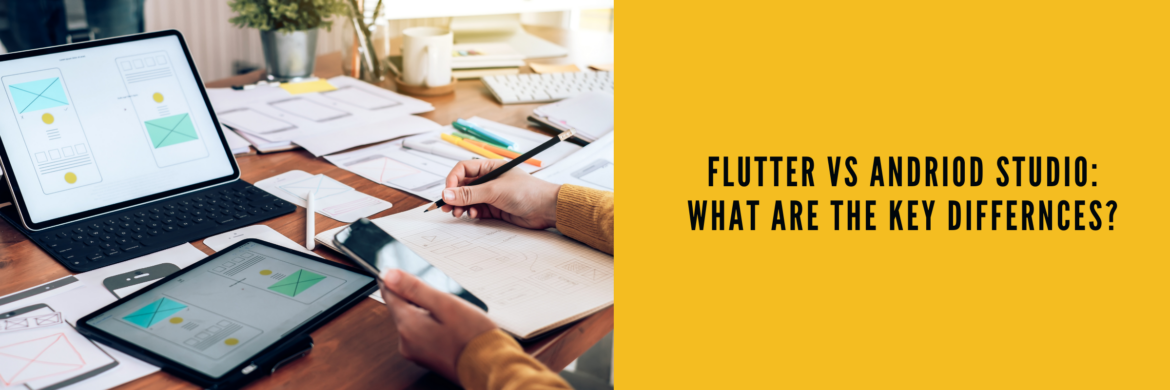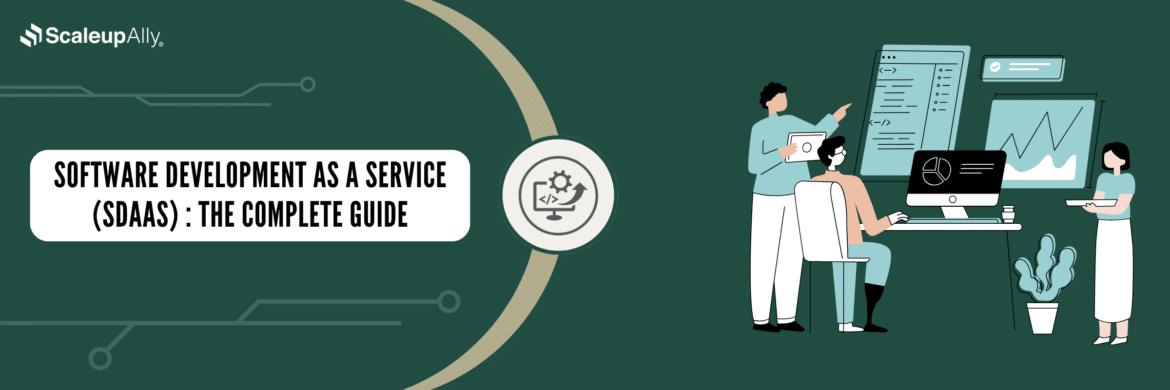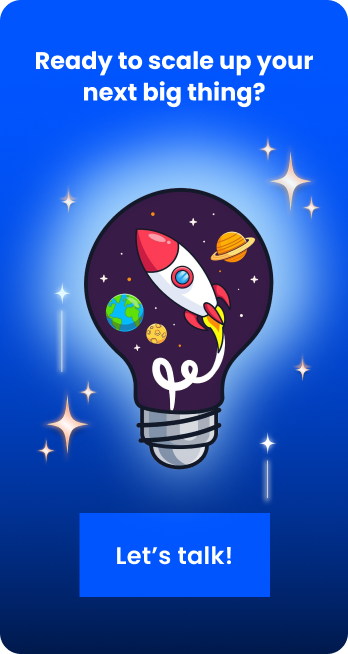
The Future of Flutter: Trends and Predictions
Suprabhat Sen | April 2, 2025 , 12 min read
Table Of Content
Flutter’s rise as a cross-platform powerhouse hasn’t been a surprising piece of luck. It’s been methodical, purposeful, and frankly, a bold challenge to the “pick one platform” mentality that dominated mobile development for years.
Companies that once dismissed Flutter as “just another framework” are now building their flagship products with it. But what’s driving this? And where is Flutter headed next?
In this blog, we will share some tips and predictions for Flutter in 2025. Though some of the predictions might sound impossible, remember that three years ago, nobody believed Flutter would support six platforms while maintaining a single codebase.
Key Takeaways
- Enterprise adoption especially in financial services has surged because of Flutter’s ability to achieve 94% code sharing between platforms.
- The integration of Web Assembly, AI-assisted development tools, and server-driven UI are changing how Flutter applications are built and deployed.
- Google is positioning Flutter as the centerpiece of their ambient computing strategy, with plans to make it the primary development tool for all their consumer products by 2026.
- Flutter has experienced growth of over a million developers using the framework.
- The framework has moved from a mobile-only solution to a cross-platform system with 68% of Flutter developers now targeting multiple platforms including web, desktop, and embedded devices.
The State of Flutter App Development: Market Growth and Adoption
Flutter continues to rank among the top projects by contributors on GitHub. Its usage jumped 46% in 2023 alone with over 150,000 Flutter apps now published in app stores worldwide.
More and more companies are now switching to Flutter. Take, for example, Nubank’s (Latin America’s largest digital bank valued at over $40 billion) switch to Flutter. It reported a merge success rate of 30% better than it was with native platforms.
The enterprise world has also taken notice. BMW, Alibaba, and eBay have gone all-in. BMW’s strategy to use Flutter for their digital ecosystem slashed their release cycles by 33% while maintaining their rigorous German engineering standards.
What’s particularly telling about the future of Flutter is retention. According to Flutter’s Survey, 92% of users are positively satisfied with Flutter’s mobile performance.
Flutter’s growth is rather not evenly distributed. It’s seeing explosive adoption in emerging markets particularly in India, Brazil, and Southeast Asia, where development teams are leaner and budgets tighter. When you can build once and deploy everywhere with native-level performance, the economic argument becomes irresistible.
This uneven global adoption suggests Flutter is potentially the backbone of the next generation of apps coming from the fastest-growing digital economies in the world.
Flutter Adoption Trends in the Last Five Years
- 26% of Flutter developers now use it for commercial/enterprise applications, up from just 11% in 2019.
- While initially mobile-focused, 68% of Flutter developers now target multiple platforms including web, desktop, and embedded devices.
- Financial services adoption increased by 217% since 2021, making it the fastest-growing sector for Flutter implementation.
- Among funded startups founded after 2021, Flutter usage stands at 38% for those developing cross-platform applications, compared to 23% for React Native.
- While North America initially dominated Flutter adoption, the Asia-Pacific region now accounts for 41% of all Flutter developers, with India representing the single largest country for Flutter development.
- From 500,000 developers in 2020 to over 1 million active developers in 2024, marking a 500% growth in just four years.
Sources: Flutter Spring Update, Medium, Stack Overflow, LeanCode, Reddit
Key Trends Shaping the Future of Flutter
The following flutter trends are pushing Flutter beyond its initial mobile-first vision.
1. Accelerated Web Assembly Integration
Flutter’s embrace of Web Assembly (WASM) represents one of its most significant pivots. Independent benchmarks show Flutter web applications running on WASM perform faster than their JavaScript counterparts. Companies have reported 2.3x faster page load times after switching their dashboard components to Flutter WASM builds.
2. AI-Assisted Development Acceleration
The integration of AI into the Flutter development workflow has seen an increase in adoption since 2022. New plugins like FlutterGPT have reduced boilerplate code writing by up to 40% in typical applications.
Google’s own DevTools now incorporate predictive coding features that can generate entire widget trees, with developers reporting measurable productivity gains. This AI-assisted approach is altering how quickly the future of Flutter applications can be prototyped and built.
3. Ambient Computing Expansion
Flutter’s “ambient computing” strategy has moved from concept to reality, with the framework now officially supporting six platforms and unofficially running on dozens more. Embedded systems adoption of Flutter grew by 218% in 2023 alone, with Toyota implementing Flutter in everything from infotainment systems to medical devices.
It is reported that 41% of Flutter developers now build for at least three different platforms from a single codebase.
4. Server-Driven UI Architecture
Server-driven UI patterns have seen explosive growth in the Flutter ecosystem, with a 189% increase in packages supporting this architecture. Companies like Nubank and Grab now dynamically control their Flutter interfaces from the server, allowing instant updates without app store approvals. This has reduced their release cycles by up to 71% while enabling A/B testing.
The shift toward server-controlled interfaces represents one of the most transformative trends in how Flutter applications are architected and maintained.
5. Dart Language Evolution
The introduction of advanced pattern matching, records, and enhanced type safety has reduced common bugs by 27% according to Google’s internal metrics. Dart’s compiler improvements have decreased average app startup times by 18% year-over-year since 2016.
Perhaps most significantly, Dart’s growing popularity (up 43% in the TIOBE index) is attracting developers from mature ecosystems like Java and Kotlin, bringing enterprise-level expertise into the Flutter community.
6. Microinteractions and Animation Focus
Flutter’s animation has become a major competitive advantage, with animation-focused packages seeing a 78% increase in downloads. Companies like Airbnb and Spotify have shifted portions of their UI to Flutter specifically for complex animations that were difficult to implement consistently across platforms.
The average Flutter application now includes 3.7x more custom animations than equivalent native applications.
7. Enterprise Tooling Maturation
The enterprise tooling ecosystem around Flutter has reached critical mass, with major players like Microsoft, IBM, and Amazon now offering official Flutter support. Enterprise adoption grew by 58% in 2023, driven by improvements in testing frameworks, CI/CD pipelines, and backend integrations.
Flutter applications now achieve an average of 90% code sharing between platforms in enterprise environments (up from 76% in 2021) significantly reducing maintenance burdens for corporate IT departments.
8. Cross-Platform Performance Parity
The performance gap between Flutter and native applications has narrowed. In standardized benchmarks, Flutter apps now achieve 96% of native performance on Android and 91% on iOS. Memory utilization has improved by 23% since Flutter 3.0, while cold start times have decreased by an average of 41% on mid-range devices.
These improvements have been particularly impactful in emerging markets, where Flutter’s more efficient resource usage has opened up new categories of applications previously considered impractical on lower-end hardware.
10 Reasons Why Flutter is the Future of App Development
Here’s why Flutter’s trajectory points to its central role in the future of application development.
1. Single Codebase, Multiple Platforms
Why Flutter continues to gain traction comes down to simple math: developing and maintaining one codebase instead of two or more translates to massive resource savings. Companies like BMW and Toyota report development time reductions of 40-60% after switching to Flutter.
With 78% of Flutter apps now deploying to multiple platforms, this is transforming how development teams structure their resources and roadmaps.
2. Superior Performance Without Native Trade-offs
Flutter’s architecture bypasses the performance limitations that plagued earlier cross-platform frameworks. By rendering directly through Skia (the same graphics engine Chrome uses) rather than relying on platform widgets, Flutter apps consistently achieve 60fps animations on mid-range hardware.
This performance parity is why companies like Alibaba chose Flutter for their main shopping app that handles over 50 million daily users without sacrificing user experience.
3. Developer Experience That Actually Delivers
The future of Flutter is being built on developer satisfaction. Hot reload (allowing code changes to appear instantly without losing state) saves an average of 80 minutes per developer daily.
When combined with Flutter’s expressive widget system, this creates a virtuous cycle: faster development leads to more experimentation, resulting in better UIs and higher user engagement.
4. Enterprise-Grade Stability
With Google’s 99.9% SLA commitment and long-term support windows now extending to 18 months, the framework meets the stability requirements previously reserved for native development.
This stability has driven a 217% increase in Fortune 500 Flutter adoption since 2021.
5. Design Consistency Without Compromise
Why Flutter excels in brand-conscious companies stems from its custom rendering engine. Unlike other frameworks that approximate platform controls, Flutter’s approach ensures pixel-perfect consistency across devices.
Nubank, valued at over $45 billion, credits this consistent brand experience as a key factor in their customer satisfaction scores improving 22% after moving to Flutter.
6. Mature Ecosystem Growth
The Flutter package ecosystem has reached critical mass, growing from 13,000 packages in 2020 to over 32,000 in 2024. More importantly, enterprise-focused packages have addressed previous gaps in areas like secure storage, authentication, and analytics that once made Flutter adoption risky for larger organizations.
7. Native Integration Without Barriers
Platform channels (Flutter’s mechanism for calling native code) have become increasingly streamlined, and Flutter apps now incorporate some native components. This allows teams to leverage platform-specific features while maintaining a primarily shared codebase.
8. Global Talent Pool Expansion
The accessible learning curve of Flutter and Dart has created the fastest-growing developer community in mobile development. For organizations building long-term technology strategies, this expanding talent pool represents a significant risk reduction compared to platform-specific expertise.
9. Embedded and IoT Frontiers
Flutter’s expansion beyond traditional computing environments signals its versatility for the coming decade. Toyota’s implementation of Flutter for their next-generation vehicle interfaces and Google’s own smart home devices running Flutter demonstrate the framework’s adaptability.
With embedded device support growing 189% since 2022, Flutter is positioning itself at the center of the connected device explosion expected to reach 75 billion devices by 2025.
10. Server-Driven Architecture Support
The future of Flutter development increasingly incorporates remote configuration and dynamic UI updates. Frameworks like FlutterFlow and AppFlowy have demonstrated how server-controlled interfaces can reduce app update cycles by up to 87%.
This architecture (allowing interface changes without app store approvals) is particularly valuable in highly regulated industries like finance and healthcare, where 46% of Flutter adoption is now occurring.
What’s Next for Flutter?
Flutter’s development roadmap is accelerating rather than stabilizing with several transformative updates on the horizon. Google revealed its focus on three key areas: performance optimization, tooling improvements, and expanded platform support.
The next major release will likely introduce significant rendering engine improvements, potentially reducing memory usage by another 15-20% based on current experimental branches.
The Dart language itself is evolving towards more functional programming paradigms with pattern matching and sealed classes becoming central to the Flutter development experience.
Google’s long-term vision positions Flutter as the cornerstone of their ambient computing strategy. Flutter will become the primary development for all Google consumer products by 2026, replacing platform-specific implementations.
This commitment includes deeper integration with Google’s AI infrastructure, allowing Flutter apps to leverage on-device machine learning with minimal configuration.Perhaps most significantly, Google is investing heavily in Flutter as their answer to the fractured state of cross-platform development.
With Microsoft embracing different approaches, Google sees Flutter as their opportunity to define the future of application development across the entire computing spectrum.
Conclusion
We’ve spent decades accepting the fragmentation of platforms as an inevitable tax on innovation. Flutter’s trajectory suggests this compromise was unnecessary all along.
For companies that resist the trend of cross-platform development, the math will become increasingly difficult to justify. Why maintain three codebases when competitors are iterating three times faster with one? Why struggle with inconsistent brand experiences when others deliver pixel-perfect interfaces across every device?
Perhaps most tellingly, the generation of developers entering the workforce today may never know a world where writing platform-specific code was the default. To them, the idea of maintaining separate implementations will seem as archaic as writing assembly code does to us now.
The future won’t be defined by Flutter versus its competitors. It will be shaped by those who embrace the cross-platform paradigm against those who cling to platform-specific development. And history rarely favors those who cling to paradigms whose time has passed.
Frequently Asked Questions
Q: Is Flutter going to be discontinued?
No, Flutter is not going to be discontinued. Google has increased investment in Flutter development, with a growing team and long-term roadmap. With over a million developers and adoption by major enterprises like BMW, Alibaba, and Nubank, Flutter is firmly established in Google’s strategic plans.
Q: Does Flutter have a future?
Flutter’s future is exceptionally strong. With 47% year-over-year growth, integration into Google’s ambient computing strategy, and increasingly widespread enterprise adoption, Flutter is positioned as a long-term framework.
Related Blogs

Developing an App Like Airbnb in 2025: Costs, Key Considerations & Money-Saving Tips
Discover the cost to build an app like Airbnb, key factors, app types, and smart ways to optimize development expenses for better ROI.
Suprabhat Sen
Jun 29 ,
10 min read

Flutter vs Android Studio: What are the Key Differences?
Flutter vs Android Studio: Wondering which technology to choose to build your next app. Here is a detailed guide that will help you make a decision.
Suprabhat Sen
Jun 28 ,
14 min read

Software Development as a Service(SDaaS): The Complete Guide
Explore how SDaaS can streamline your development process, reduce costs, and boost your competitive edge. Learn how SDaaS can empower your business.
Suprabhat Sen
Jun 28 ,
16 min read








